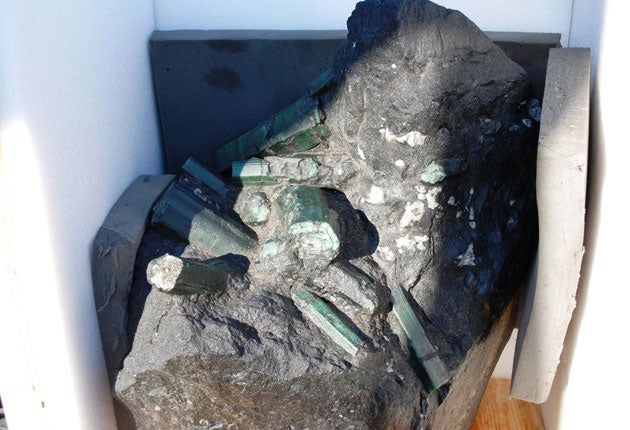There is a touch of the Indiana Jones about the case in which Los Angeles Superior Court Judge John Kronstadt is hearing evidence. Its back-story reads like the script to a Hollywood movie, and the value of its outcome, which by some estimates could be as much as $1bn, puts it easily into blockbuster territory.
At stake is the ownership of the Bahia Emerald, a vast uncut gem embedded in a block of grey rock. It weighs 840lbs(341kg) or 180,000 carats, which is roughly the same as a small horse. Currently, it sits in a locked room at the City Sheriff's Department.
This being America, at least six different people have filed lawsuits so far claiming the Bahia Emerald belongs to them and several credible contenders remain; the first of their number, a swashbuckling 46-year-old businessman from southern California called Anthony Thomas, had his day in court last week.
The murky tale that emerged in the air-conditioned courtroom involved dodgy deeds and derring-do across two continents.
At one point, the stone turned up in a flooded New Orleans warehouse after Hurricane Katrina; at another it was shown to Vidal Sassoon and the late TV host Merv Griffin. Later, it was spotted in a San Jose warehouse, next to bean-sprouts being grown under high-wattage lights.
About the only thing the various plaintiffs and their teams of lawyers agree on is this: the Bahia Emerald was first dug up by two Brazilian miners, Ruy Saraiva Filho and Elson Alves Ribereiro, in 2001, and was taken into custody seven years later by US police investigating a claim of theft.
Judge Kronstadt has agreed to hear each of the somewhat complex claims to the gemstone, one after another, over the coming months. With the agreement of all the plaintiffs (who clearly realise that they are not the sort of individuals a jury would easily warm to), he alone will then decide which of them, if any, should be entitled to keep it.
Mr Thomas was the first of the "big" claimants to make his case, giving several days of evidence starting on Tuesday. A serious gem collector, he claims to have flown to Brazil shortly after hearing of the emerald's discovery and agreed to purchase it directly from the miners, for $60,000 (£37,000). But the emerald never arrived, and he was later told it had been stolen.
In support of his case, Mr Thomas showed photographs of him with the emerald. He also claimed to have received a "bill of sale" after purchasing it, but claimed it disappeared when his house burned down in 2006.
Asked why the document was not in the safety deposit box where he keeps other valuables, he said: "I have no explanation. People do things."
When his evidence has concluded, the court will hear from Ken Conetto, a former friend of Mr Thomas's, who fell out with him over the emerald. He claims to have purchased the stone in Brazil and shipped it to San Jose some time in 2005, where he subsequently attempted to sell it, offering 25 per cent commission to any agent who could fetch an acceptable sum.
Various gemologists took possession of the stone in the ensuing three years, shipping it around the US to potential buyers. It was spotted in Idaho, Nevada and Los Angeles. At one point, it was even offered for sale on eBay, with a "buy it now" price of $75m.
Though Mr Conetto insists the various sellers who had possession of the stone were merely acting as agents, several of them have since claimed that they own it. One such man is Larry Biegler, the LA dealer who told police it had been stolen in 2008. He has since withdrawn his suit, however, saying that his life has been threatened as a result of it.
Others are Todd Armstrong and Kit Morrison – who were attempting to sell the emerald in Las Vegas when the police confiscated it. They claim Mr Biegler gave it to them as collateral on a $700,000 shipment of diamonds which never arrived. Another contender is Mark Downie, who claims to have paid $81,000 for it in 2005 to a firm called Greenworks Mining.
Legal experts say the outcome of the trial is anyone's guess. Royal Oakes, a courtroom analyst for NBC, said yesterday that the case is likely to hinge on who can present the most compelling documentary evidence.
"Judges are grizzled veterans in cases involving contract disputes or alleged fraud with large sums of money at stake, and they tend to be cynical about people who claim to be due huge amounts of money without having their evidence lined up neatly," he said. "A case like this is all about paperwork."
In the ongoing confusion, with endless claims and counter-claims, Mr Oakes added that little is guaranteed except that the trial will take several months and that an awful lot of lawyers will make plenty of money. The case continues.

Join our commenting forum
Join thought-provoking conversations, follow other Independent readers and see their replies
Comments